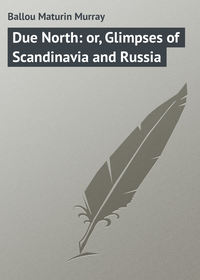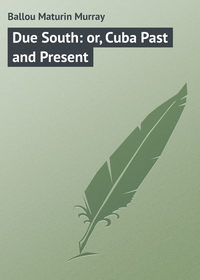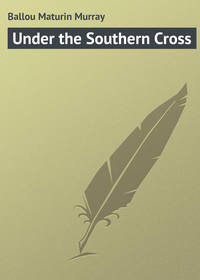 полная версия
полная версияFoot-prints of Travel: or, Journeyings in Many Lands

Ballou Maturin Murray
Foot-prints of Travel Or Journeyings in Many Lands
PREFACE
In these notes of foreign travel the object has been to cover a broad field without making a cumbersome volume, to do which, conciseness has necessarily been observed. In previous books the author has described much more in detail some of the countries here briefly spoken of. The volumes referred to are "Due-West; or, Round the World in Ten Months," and "Due-South; or, Cuba Past and Present," which were published by Houghton, Mifflin & Co., of Boston. Two other volumes, namely, "Due-North; or, Glimpses of Scandinavia and Russia," and "Under the Southern Cross; or, Travels in Australia and New Zealand," were issued by Ticknor & Co., of the same city. By the kind permission of both publishers, the author has felt at liberty to use his original notes in the preparation of these pages. It should be understood, however, that about one-half of the countries through which the reader is conducted in the present work are not mentioned in the volumes above referred to. The purpose has been to prepare a series of chapters adapted for youth, which, while affording pleasing entertainment, should also impart valuable information. The free use of good maps while reading these Foot-prints of Travel, will be of great advantage, increasing the student's interest and also impressing upon his mind a degree of geographical knowledge which could not in any other way be so easily or pleasantly acquired.
M. M. B.CHAPTER I
The title of the book in hand is sufficiently expressive of its purpose. We shall follow the course of the sun, but diverge wherever the peculiarities of different countries prove attractive. As the author will conduct his readers only among scenes and over routes which he himself has travelled, it is hoped that he may be able to impart a portion of the enjoyment experienced, and the knowledge gained in many foreign lands and on many distant seas.
Starting from the city of Boston by railway, we pass at express speed through the length of Massachusetts from east to west, until we arrive at Hoosac, where the famous tunnel of that name is situated. This remarkable excavation, five miles in length, was cut through the solid rock of Hoosac Mountain to facilitate transportation between Boston and the West, at a cost of twenty years of labor and sixteen millions of dollars; a sum, which, were it divided, would amount to over five dollars per head for every man, woman, and child in the State.
By a continuous day's journey from Boston, we reach Niagara late at night. The best view of the falls, which form the grandest cataract on the globe, is to be enjoyed from the Canada side of the Niagara River. In the midst of the falls is Goat Island, dividing them into two unequal parts, one of which forms the American, and the other the Horse Shoe Fall, so called from its shape, which is on the Canada side. As we gaze upon this remarkable exhibition of natural force, a column of vapor rises two hundred feet above the avalanche of waters, white as snow where it is absorbed into the skies, the base being wreathed with perpetual rainbows. A canal, starting from a convenient point above the falls and extending to a point below the rapids, utilizes for mill purposes an infinitesimal portion of the enormous power which is running to waste, night and day, just as it has been doing for hundreds of years. It is well known that many centuries ago these falls were six miles nearer to Lake Ontario than they now are, making it evident that a steady wearing away of the rock and soil is all the time progressing. The inference seems to be plain enough. After the lapse of ages these mammoth falls may have receded so far as to open with one terrific plunge the eastern end of Lake Erie. Long before the Falls are reached we hear the mighty roar which made the Indians call the cataract Niagara, or "the thunder of the waters." On leaving here, we cross the river by a suspension bridge, which, from a short distance, looks like a mere spider's web. Over this the cars move slowly, affording a superb view of the Falls and of the awful chasm below.
But let us not dwell too long upon so familiar a theme. After a day and night in the cars, travelling westward, Chicago, the capital of Illinois, is reached. About sixty years ago a scattered tribe of the Pottawatomies inhabited the spot on the shore of Lake Michigan, where is now situated the most important capital of the North Western States. In 1837 the city was formed with less than five thousand inhabitants; at this writing it has nearly a million. Such rapid growth has no parallel in America or elsewhere. This commercial increase is the natural result of its situation at the head of the great chain of lakes. In size it is a little over seven miles in length by five in width, giving it an area of about forty square miles. The city is now the centre of a railroad system embracing fifteen important trunk lines, forming the largest grain, lumber, and livestock market in the world. One hundred and sixty million bushels of grain have passed through its elevators in a twelvemonth.
On our way westward, we stop for a day at Salt Lake City, the capital of Utah, some sixteen hundred miles from Chicago. The site of the present town was an unbroken wilderness so late as 1838, but it now boasts a population of twenty-six thousand souls. The peculiar people who have established themselves here, have by industry and a complete system of irrigation, brought the entire valley to a degree of fertility unsurpassed by the same number of square miles on this continent. It is not within our province to discuss the domestic life of the Mormons. No portrait of them, however, will prove a likeness which does not clearly depict their twofold features; namely, their thrift and their iniquity. Contact with a truer condition of civilization, and the enforcement of United States laws, are slowly, but it is believed surely, reducing the numbers of the self-entitled "saints." Mormon missionaries, however, still seek to make proselytes in France, Norway, Sweden, and Great Britain, addressing themselves always to the most ignorant classes. These poor half-starved creatures are helped to emigrate, believing that they are coming to a land flowing with milk and honey. In most cases any change with them would be for their advantage; and so the ranks of Mormonism are recruited, not from any truly religious impulse in the new disciples, but through a desire to better their physical condition.
From Utah, two days and a night passed in the cars will take us over the six hundred intervening miles to San Francisco. The route passes through the Sierra Nevada Mountains, presenting scenery which recalls the grand gorges and snow-clad peaks of Switzerland and Norway, characterized by deep canyons, lofty wooded elevations, and precipitous declivities. At the several railway stations specimens of the native Shoshones, Piutes, and other tribes of Indians are seen lazily sunning themselves in picturesque groups. The men are dirty and uncouth examples of humanity, besmeared with yellow ochre and vermilion; their dress consisting of loose flannel blankets and deerskin leggings, their rude hats decked with eagle feathers. The women are wrapped in striped blankets and wear red flannel leggings, both sexes being furnished with buckskin moccasins. The women are fond of cheap ornaments, colored glass beads, and brass ear-rings. About every other one has a baby strapped to her back in a flat basket. Men and squaws wear their coarse jet-black hair in long, untidy locks, hanging over their bronzed necks and faces. War, whiskey, and want of proper food are gradually blotting out the aboriginal tribes of America.
San Francisco, less than forty years of age, is the commercial metropolis of California, which State, if it lay upon the Atlantic coast, would extend from Massachusetts to South Carolina. It covers a territory five times as large as the whole of the New England States combined, possessing, especially in its southern division, a climate presenting most of the advantages of the tropics with but few of the objections which appertain to the low latitudes. The population of San Francisco already reaches an aggregate of nearly four hundred thousand. Owing its first popular attraction to the discovery of gold within its borders, in 1849, California has long since developed an agricultural capacity exceeding the value of its mineral productions. The future promise and possibilities of its trade and commerce defy calculation.
The Cliff House, situated four or five miles from the centre of the city, is a favorite pleasure resort of the population. It stands on a bluff of the Pacific shore, affording an ocean view limited only by the power of the human vision. As we look due west from this spot, no land intervenes between us and the far-away shore of Japan. Opposite the Cliff House, three hundred yards from the shore, there rises abruptly out of the sea, from a depth of many fathoms, a rough, precipitous rock, sixty or seventy feet in height, presenting about an acre of surface. Sea-lions come out of the water in large numbers to sun themselves upon this rock, affording an amusing sight from the shore. These animals are of all sizes, according to age, weighing from fifty to one thousand pounds, and possessing sufficient muscular power to enable them to climb the rock, where a hundred are often seen at a time. The half roar, half bark peculiar to these creatures, sounds harsh upon the ear of the listeners at the Cliff. The law of the State protects them from molestation, but they quarrel furiously among themselves. The sea-lion belongs to the seal family and is the largest of its species.
A week can hardly be more profitably occupied upon our route than by visiting the Yosemite Valley, where the grandeur of the Alpine scenery is unsurpassed, and where there are forests which produce giant trees of over three hundred feet in height and over thirty in diameter. The ascent of the mountain which forms the barrier to the valley, commences at a place called Clark's, the name of the person who keeps the hotel, and which is the only dwelling-house in the neighborhood. The stage is drawn upwards over a precipitous, winding road, by relays of six stout horses, to an elevation of seven thousand feet, leaving behind nearly all signs of human habitation. A mournful air of loneliness surrounds us as we creep slowly towards the summit; but how grand and inspiring are the views which are seen from the various points! One falls to analyzing the natural architecture of these mountain peaks, gulches, and cliffs, fancy making out at times well-defined Roman circuses; again, castellated crags come into view, resembling half-ruined castles on the Rhine; other crags are like Turkish minarets, while some rocky ranges are dome-capped like St. Peter's at Rome. Far below them all we catch glimpses of dark ravines of unknown depths, where lonely mist-wreaths rest like snow-drifts.
Nestling beside the roadway, there are seen here and there pale wild-flowers surrounded by vigorous ferns and creeping vines, showing that even here, in these lofty and deserted regions, Nature has her poetic moods. Birds almost entirely disappear at these altitudes, preferring the more genial atmosphere of the plains, though now and again an eagle, with broad spread pinions, is seen to swoop gracefully from the top of some lonely pine, and sail with unmoving wings far away across the depth of the valley until hidden by the windings of the gorge. Even the presence of this proud and kingly bird but serves to emphasize the loneliness of these silent heights.
By and by the loftiest portion of the road is reached at what is known as Inspiration Point, whence a comprehensive view is afforded of the far-famed valley. Though we stand here at an elevation of over seven thousand feet above the plains so lately crossed, still the Yosemite Valley, into which we are gazing with awe and admiration, is but about three thousand five hundred feet below us. It runs east and west, appearing quite contracted from this great height, but is eight miles long by over one in width. On either side rise vertical cliffs of granite, varying from three to four thousand feet in height, several of the lofty gorges discharging narrow but strikingly beautiful and transparent water-falls. Upon descending into the valley, we find ourselves surrounded by precipitous mountains, nearly a score in number, the loftiest of which is entitled Starr King, after the late clergyman of that name, and is five thousand six hundred feet in height. But the Three Brothers, with an average height of less than four thousand feet, and Sentinel Dome, measuring four thousand five hundred feet high, seem to the casual observer to be quite as prominent, while El Capitan, which is about three thousand three hundred feet in height, appears from its more favorable position to be the most striking and effective of them all. Eleven water-falls of greater or less magnitude come tumbling into the valley, adding to the picturesqueness of the scene. Of these several falls, that which is known as the Bridal Veil will be sure to strike the stranger as the finest, though not the loftiest. The constant moisture and the vertical rays of the sun carpet the level plain of the valley with a bright and uniform verdure, through the midst of which winds the swift-flowing Merced River, adding completeness to a scene of rare and enchanting beauty.
It was not until so late as the year 1851 that the foot of a white man ever trod the valley, which had for years proven the secure hiding-place of marauding Indians. In their battles with the whites, the latter were often surprised by the sudden disappearance of their foes, who vanished mysteriously, leaving no traces behind them. On these occasions, as was afterwards discovered, they fled to the almost inaccessible Yosemite Valley. Betrayed at last by a treacherous member of their own tribe, the Indians were surprised and nearly all destroyed. There is scarcely a resident in the valley except those connected with the running of the stages during the summer months, and those who are attached to the hotel. It is quite inaccessible in winter. An encampment of native Indians is generally to be seen in the warm months, located on the river's bank, under the shade of a grove of tall trees; the river and the forest afford these aborigines ample food. For winter use they store a crop of acorns, which they dry, and grind into a nourishing flour. They are a dirty, sad-looking race, far more repulsive in appearance than the lowest type of Spanish gypsies one meets in Andalusia.
In returning from the Yosemite to San Francisco, let us do so by the road leading through the Mariposa Grove of Big Trees. These forest monarchs are situated in a thickly wooded glade hundreds of feet up the slope of the Sierra. We find one of these trees partially decayed towards its base, yet still alive and standing upright with a broad, lofty passage-way through its entire trunk, large enough for our stage, laden with passengers inside and out, to drive through. Though time has made such havoc with this trunk, it still possesses sufficient vitality to bear leaves upon its topmost branches, some three hundred feet above the ground. It is curious that these enormous trees, among the largest upon the globe, have cones only about the size of walnuts, with seeds of hardly a quarter of an inch in length. There are trunks lying upon the ground in this remarkable grove which are believed to be two thousand years of age; and others upright, and in growing condition, which are reckoned by their clearly defined annual rings, to be thirteen hundred years old. The region embraced in what is known as the Yosemite Valley has been ceded by the National Government to the State of California, on the express condition that it shall be kept inviolate in its present wild and natural state for all time.
The streets, alleys, and boulevards of San Francisco present a panorama of human interest rarely excelled in any part of the world. How impressive to watch its cosmopolitan life, to note the exaggerated love of pleasure exhibited on all hands, the devotion of each active member of the community to money-making, the prevailing manners and customs, the iniquitous pursuits of the desperate and dangerous classes, and the readiness of their too willing victims! It is the solitary looker-on who sees more than the actors in the great drama of every-day life. Above all, it is most curious to observe how the lines of barbarism and civilization intersect along these teeming avenues.
There is a district of the city near its very centre, known as Chinatown, which is at total variance with the general surroundings. It requires but a slight stretch of the imagination after passing its borders to believe one's self in Canton or Hong Kong, except that the thoroughfares in the Asiatic capitals are mere alleys in width, shut in overhead and darkened by straw mats, while here we have broad streets after the American and European fashion, open to the sky. They are, however, lined with Chinese shops, decked in all their national peculiarities, exhibiting the most grotesque signs, while the windows are crowded with outlandish articles, and the whole surrounded by an Oriental atmosphere. This section is almost entirely peopled by Mongolians, and such poor abandoned men and women of other nationalities as seek among these repulsive surroundings to hide themselves from the shame and penalty of their crimes.
It is not proposed in these Foot-Prints of Travel to remain long on this continent. Americans are presumed to be quite familiar with their native land; so we will embark without delay upon a voyage across the Pacific Ocean to Japan, by way of the Sandwich Islands. Once on board ship, we quickly pass through the Golden Gate, as the entrance to the spacious harbor of San Francisco is called, steering south-southwest towards the Hawaiian group, which is situated a little over two thousand miles away. The great seas and oceans of the globe, like the land, have their geographical divisions and local peculiarities, varying essentially in temperature, products, and moods; now marked by certain currents; now noted for typhoons and hurricanes; and now lying in latitudes which are favored with almost constant calms and unvarying sunshine. By a glance at the map we shall see that a vessel taking her course for New Zealand, for instance, by the way of the Sandwich Islands, will pass through a tract of the Pacific Ocean seemingly so full of islands that we are led to wonder how a ship pursuing such a route can avoid running foul of some of the Polynesian groups. But it must be remembered that the distances which are so concisely depicted to our eyes upon the map, are yet vast in reality, while so mathematically exact are the rules of navigation, and so well known are the prevailing currents, that a steamship may make the voyage from Honolulu to Auckland, a distance of four thousand miles, without sighting land. When Magellan, the Portuguese navigator, first discovered this great ocean, after sailing through the straits which bear his name, he called it the Pacific Ocean, and perhaps it seemed "pacific" to him after a stormy voyage in the Caribbean Sea; but portions of its surface are quite as restless and tempest-tossed as are the waters of any part of the globe. The Pacific measures nine thousand miles from north to south, and is ten thousand miles broad between Quito, South America, and the Moluccas or Spice Islands. At the extreme north, where Behring's Strait divides the continents of Asia and America, it is scarcely more than forty miles in width, so that in clear weather one can see the shores of Asia while standing on our own continent.
It is an eight days' voyage by steamship from San Francisco to Honolulu, giving the traveller ample time to familiarize himself with many peculiarities of this waste of waters. Occasionally a whale is sighted, throwing up a small column of water as it rises at intervals to the surface. A whale is not a fish; it differs materially from the finny tribe, and can as surely be drowned as can a man. Whales bring forth living young; they breathe atmospheric air through their lungs in place of water through gills, having also a double heart and warm blood, like land animals. Flying-fish are frequently seen, queer little creatures, resembling the smelts of our northern waters. While exhibiting the nature of a fish, they have also the soaring ambition of a bird. Hideous, man-eating sharks are sure to follow in the ship's wake, watching for some unfortunate victim of a sailor or passenger who may fall overboard, and eagerly devouring any refuse thrown from the cook's galley. At times the many-armed cuttlefish is seen to leap out of the water, while the star-fish, with its five arms of equal length, abounds. Though it seems so apparently lifeless, the star-fish can be quite aggressive when pressed by hunger, having, as naturalists tell us, a mysterious way of causing the oyster to open its shell, when it proceeds gradually to consume the body of the bivalve. One frail, small rover of the deep is sure to interest the voyager; namely, the tiny nautilus, with its transparent covering, almost as frail as writing-paper. No wonder the ancient Greeks saw in its beautifully corrugated shell the graceful model of a galley, and hence its name, derived from the Greek word which signifies a ship. Sometimes a pale gray, amber-like substance is seen floating upon the surface of the sea, which, upon examination, proves to be ambergris, a substance originally found in the body of the sperm whale, and which is believed to be produced there only. Scientists declare it to be a secretion caused by disease in the animal, probably induced by indigestion, as the pearl is said to be a diseased secretion of the Australian and Penang oysters. Ambergris is not infrequently found floating along the shores of the Coral Sea, and about the west coast of New Zealand, having been ejected by the whales which frequent these waters. When first taken from the animal it is of a soft texture, and is offensive to the smell; but after a brief exposure to the air it rapidly hardens, and then emits a sweet, earthy odor, and is used in manufacturing choice perfumery.
The harbor of San Francisco abounds in big, white sea-gulls, which fly fearlessly in and out among the shipping, uttering defiant screams, or floating gracefully like corks upon the water. They are large, handsome, dignified birds, and are never molested, being looked upon as picturesque ornaments to the harbor; and they are also the most active of scavengers, removing all sorts of floating carrion and refuse which is thrown overboard. The gulls one sees off the coast of Norway are numbered by thousands, but they are not nearly so large as these bird monarchs of the Pacific. A score of these are sure to accompany us to sea, closely following the ship day after day, living mostly upon the refuse thrown out from the steward's department. In the month of October, 1884, one of these birds was caught by the passengers upon a steamship just as she was leaving the coast of America for Japan. A piece of red tape was made fast to one of its legs, after which it was restored to liberty. This identical gull followed the ship between four and five thousand miles, into the harbor of Yokohama. Distance seems to be of little account to these buoyant navigators of the air.
On approaching the Hawaiian group from the north, the first land which is sighted is the island of Oahu, and soon after we pass along the windward shores of Maui and Molokai, doubling the lofty promontory of Diamond Head, which rears its precipitous front seven hundred feet above the sea. We arrive at the dawn of day, while the rising sun beautifies the mountain tops, the green slopes, the gulches, and fern-clad hills, which here and there sparkle with silvery streamlets. The gentle morning breeze blowing off the land brings us the dewy fragrance of the flowers, which has been distilled from a wilderness of tropical bloom during the night. The land forms a shelter for our vessel, and we glide noiselessly over a perfectly calm sea. As we draw nearer to the shore, sugar plantations, cocoanut groves, and verdant pastures come clearly into view. Here and there the shore is dotted with the low, primitive dwellings of the natives, and occasionally we see picturesque, vine-clad cottages of American or European residents. Approaching still nearer to the city of Honolulu, it seems to be half-buried in a cloud of luxuriant foliage, while a broad and beautiful valley stretches away from the town far back among the lofty hills.









